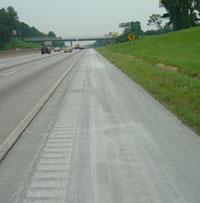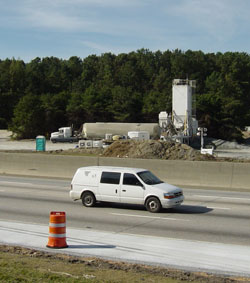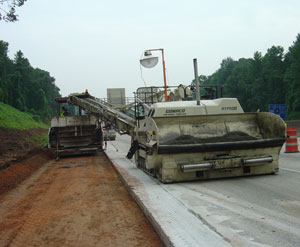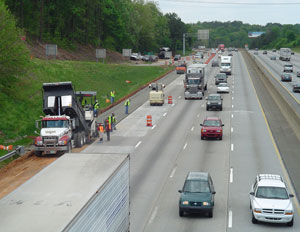 In recent years, the Georgia Department of Transportation has spent time investigating roller-compacted concrete (RCC) pavement and its potential value to their program. The speed of construction, durability, and economy offered by roller-compacted concrete pavement were attributes that made it a long-term solution for GDOT pavement management. When the west side of I-285 came due for rehabilitation, RCC represented a logical choice for the reconstruction of the failing shoulders.
In recent years, the Georgia Department of Transportation has spent time investigating roller-compacted concrete (RCC) pavement and its potential value to their program. The speed of construction, durability, and economy offered by roller-compacted concrete pavement were attributes that made it a long-term solution for GDOT pavement management. When the west side of I-285 came due for rehabilitation, RCC represented a logical choice for the reconstruction of the failing shoulders.
Spanning 17.3 miles along the west side of Atlanta’s Perimeter Beltway, the I-285 project consisted of concrete pavement rehabilitation (select slab replacements) on the mainline, and reconstruction of the outside shoulders both northbound and southbound. The general contractor for this project was Pittman Construction Company, based in Conyers, Georgia. The mainline slab replacements were performed by Costello Industries, Inc., College Park, Georgia, with the RCC paving handled by A.G. Peltz, LLC, Birmingham, Alabama.
Traffic volume and minimizing impact to the traveling public are always serious considerations for the GDOT when evaluating any improvement project. The necessary one-lane closures for RCC construction started at 9 p.m. Friday evening and continued through 5 a.m. Monday morning, with the option of limited working hours at night Monday through Thursday.
Removal of the existing failed shoulders began Friday evenings with the milling and removal of the existing asphalt and subbase material to 11½ feet wide. The units use a grade control system provided the required depth of removal at the mainline pavement edge and slope control to hold the depth at the outside edge. This equipment allowed for the removal of 1.5 to 2.0 lane-miles of shoulder material between 9 p.m. on Friday and 5 a.m. on Saturday (an eight hour period). Milled asphalt from the project was discharged directly into trucks for subsequent hauling to local interchanges, where it was used for improvements.
Placement of the new RCC shoulders began early Saturday mornings and wound down each Sunday in order to make the highway ready for Monday morning traffic. The shoulders were constructed 10 feet wide with depths of six inches and eight inches as indicated by the GDOT design.
 The RCC material was manufactured on-site in a continuous pug-mill operation. This unit produces RCC at rates of up to 500 tons per hour (250 cubic yards per hour) to meet the demands of the paving crew.
The RCC material was manufactured on-site in a continuous pug-mill operation. This unit produces RCC at rates of up to 500 tons per hour (250 cubic yards per hour) to meet the demands of the paving crew.
The RCC mix design was developed by A.G. Peltz, LLC, in conjunction with CMS Labs of Locust Grove, Georgia and approved for use through the GDOT Office of Materials and Research. The aggregate was a densely graded blend of fine and coarse aggregates with a nominal maximum size of ½ inch with cement and water rounding out the mix.
The paving operation consisted of an ABG Titan high density paving machine with a dual tamping bar in the screed. This machine has the capability of paving to a width of more than 40 feet and nearly 10 inches per lift while achieving densities of up to 95 percent (modified proctor) density. This paving unit was used in conjunction with a Gomaco Material Transfer Vehicle to ensure a consistent flow of material which, ultimately, contributed to an improved ride quality.
Compaction immediately followed placement, with a 10-ton Hamm oscillating steel drum roller and an Ingersoll-Rand combination roller both staying busy throughout the operation. The rolling pattern was established using a nuclear density gauge with a target of 98 percent density. This was accomplished using the roller in a combination of vibratory and static modes.
Immediately after placement and compaction, nuclear density tests were performed. The project required a 98 percent average density with no test below 95 percent. Additionally, the specification called for a surface smoothness not exceeding ¼ inch deviation under a 10-foot straight edge.
 The paving contractor completed the RCC placement process with an application of a white pigmented curing compound which allowed the RCC to retain the moisture required to build strength quickly. This curing compound was applied with a custom, wheel mounted, tank and spraybar unit for easy and uniform application.
The paving contractor completed the RCC placement process with an application of a white pigmented curing compound which allowed the RCC to retain the moisture required to build strength quickly. This curing compound was applied with a custom, wheel mounted, tank and spraybar unit for easy and uniform application.
Within the first two hours of placement, an early entry (Soff-Cut) saw cut contraction joints to match the adjacent mainline pavement. Joint sealing and grinding of rumble strips completed the process and provided a shoulder pavement that will have long-term performance.
 As traffic volumes steadily increase and funding is continually stretched, roller-compacted concrete is becoming a pavement of choice for many applications. Its economical price, long-term performance, low maintenance and quick return to traffic have positioned RCC pavement as a value-engineered material that should be well suited to many applications.
As traffic volumes steadily increase and funding is continually stretched, roller-compacted concrete is becoming a pavement of choice for many applications. Its economical price, long-term performance, low maintenance and quick return to traffic have positioned RCC pavement as a value-engineered material that should be well suited to many applications.
RCC Case Histories
Click here for more RCC case histories.